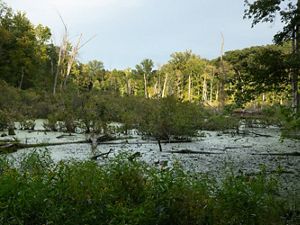Wet and Wild: The Weird, Wondrous and Wicked Cool Creatures in Midwest Wetlands
Wetlands support an incredible diversity of life. Yet they’re in danger: in some states, as much as 90% of wetlands have been destroyed.
Wetlands—areas where water is present at or near the surface of the soil some or all of the year—truly are where the wild things are. Microorganisms thrive in the damp soil. Dragonflies glide above the muck. Salamanders and frogs hide among carnivorous plants, and herons and beavers wade in the water.
They are also among the most productive ecosystems in the world. Wetlands are, in essence, “biological supermarkets” that produce immense amounts of food and attract and sustain countless numbers of animal species.
Why are wetlands important?
In Wisconsin, 75% of the state’s wildlife depend on wetlands at some point in their life, and 40% of the threatened and endangered plants and animals in Illinois rely on wetland habitat. Isolated wetlands in Indiana harbor the federally endangered Mitchell’s satyr butterfly, which is only found in two states.
Wetlands are also key to fighting and adapting to climate change. They hold significant amounts of the world’s soil carbon, provide water storage to reduce flooding, filter pollutants from water to keep it clean, provide a refuge for species needing wetter conditions in drought prone areas, and so much more.
Despite the diversity of life they support and their outsize role in tackling climate change, wetlands are at risk. Wetlands have been—and continue to be—drained and filled in order to make way for agriculture or development. Roughly half of Michigan’s and Wisconsin’s wetland acreage has been lost—but that’s better than other Midwest states such as Ohio and Illinois, where only about 10% of historic wetlands remain.
How is TNC protecting our Midwest wetlands?
To address the interconnected crises of rapid climate change and biodiversity loss, The Nature Conservancy is studying, protecting, restoring and spreading the word about wetlands across the Midwest.
- Our efforts to improve habitat connectivity including linking backwater swamps, streams and lakes at our Emiquon Preserve make it the largest floodplain restoration project in the Midwest. Emiquon is home to hundreds of thousands of migratory and resident birds including American bald eagles and white pelicans, as well as mammals such as river otters, muskrats and beavers.
- The crescent-shaped oxbow lakes along the Wabash River in southwestern Indiana provide habitat for river fish, many of which use these lakes as nurseries for their young. We are working with researchers to determine where oxbow lake protection and restoration efforts will have the greatest impact.
- In partnership with the Wisconsin Department of Natural Resources, we created Wetlands by Design, an online tool to help decision-makers identify best places to protect and restore wetlands across the state.
- In Ohio, we are sharing the importance of vernal pools with visitors to our Morgan Swamp Preserve. Vernal pools last only for a few months each year, but they provide breeding habitat for many species including rare blue-spotted and four-toed salamanders.
- We are restoring coastal wetlands at our Erie Marsh Preserve in Michigan—which means re-engineering the land to improve habitat and to increase fish passage.

Stay in the Loop
Get monthly updates on your state's conservation efforts.
What wildlife live in wetlands?
Swamps, bogs and marshes might conjure mysterious, foggy images of stagnant water and slimy mud. But wetlands are active, dynamic and vibrant places where an incredible web of life exists in careful balance.
Where can I visit a wetland?
All wetlands are not created equal. Some are wet year-round, while others only hold water at specific times of year, and each type of wetland shelters uniquely adapted flora and fauna.
See for yourself by exploring a wetland near you. To help you get started, we’ve created a map showing some of the many Nature Conservancy preserves in the Midwest where you can immerse yourself in the beauty and diversity of wetlands. All you need is a little time and lots of curiosity!
Midwest Wetlands Visit our preserves to experience the wild wetlands of the Midwest!
But…what about MOSQUITOES?
Don’t be afraid to visit wetlands because of the bugs! Find out why from Alyssa Nyberg, TNC’s restoration ecologist in Indiana.
Wild about Wetlands?
Donate today to help us protect these weird, wonderful natural areas!
Donate Now






















